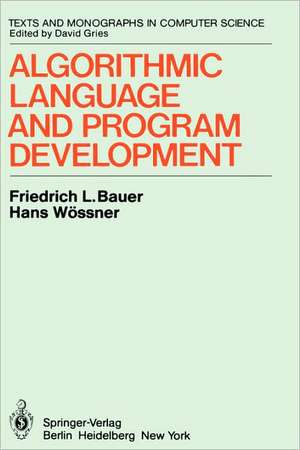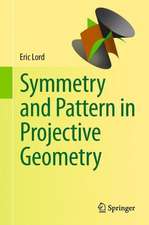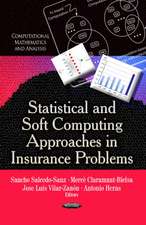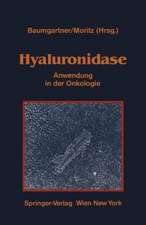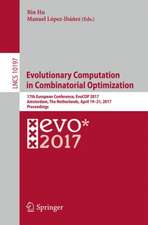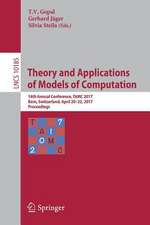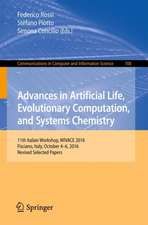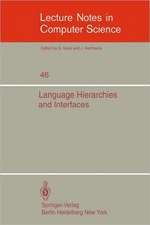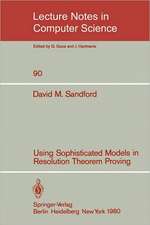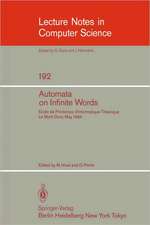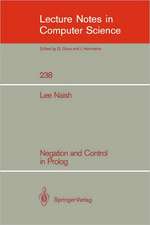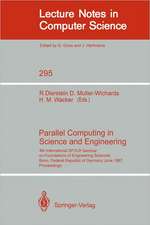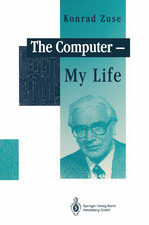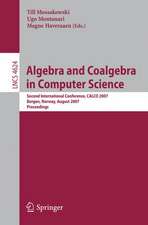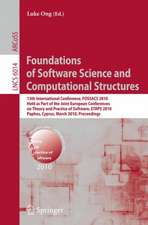Algorithmic Language and Program Development: Monographs in Computer Science
H. Partsch Autor F. L. Bauer P. Pepper Autor H. Wössneren Limba Engleză Hardback – oct 1982
| Toate formatele și edițiile | Preț | Express |
|---|---|---|
| Paperback (1) | 343.44 lei 6-8 săpt. | |
| Springer Berlin, Heidelberg – 19 oct 2011 | 343.44 lei 6-8 săpt. | |
| Hardback (1) | 349.40 lei 6-8 săpt. | |
| Springer Berlin, Heidelberg – oct 1982 | 349.40 lei 6-8 săpt. |
Din seria Monographs in Computer Science
- 20%
 Preț: 1322.33 lei
Preț: 1322.33 lei - 20%
 Preț: 511.92 lei
Preț: 511.92 lei - 20%
 Preț: 1285.31 lei
Preț: 1285.31 lei - 20%
 Preț: 333.22 lei
Preț: 333.22 lei - 20%
 Preț: 328.60 lei
Preț: 328.60 lei - 15%
 Preț: 646.94 lei
Preț: 646.94 lei - 20%
 Preț: 357.48 lei
Preț: 357.48 lei - 20%
 Preț: 339.47 lei
Preț: 339.47 lei - 20%
 Preț: 653.21 lei
Preț: 653.21 lei - 20%
 Preț: 329.44 lei
Preț: 329.44 lei - 20%
 Preț: 993.74 lei
Preț: 993.74 lei - 20%
 Preț: 992.26 lei
Preț: 992.26 lei - 20%
 Preț: 1630.95 lei
Preț: 1630.95 lei - 20%
 Preț: 656.03 lei
Preț: 656.03 lei - 20%
 Preț: 650.08 lei
Preț: 650.08 lei - 20%
 Preț: 328.09 lei
Preț: 328.09 lei - 20%
 Preț: 641.16 lei
Preț: 641.16 lei - 20%
 Preț: 334.38 lei
Preț: 334.38 lei - 18%
 Preț: 737.74 lei
Preț: 737.74 lei - 20%
 Preț: 642.19 lei
Preț: 642.19 lei - 20%
 Preț: 641.99 lei
Preț: 641.99 lei - 20%
 Preț: 345.59 lei
Preț: 345.59 lei - 20%
 Preț: 711.29 lei
Preț: 711.29 lei - 20%
 Preț: 1001.16 lei
Preț: 1001.16 lei - 20%
 Preț: 661.47 lei
Preț: 661.47 lei - 20%
 Preț: 343.62 lei
Preț: 343.62 lei - 20%
 Preț: 644.81 lei
Preț: 644.81 lei - 15%
 Preț: 505.30 lei
Preț: 505.30 lei - 20%
 Preț: 640.69 lei
Preț: 640.69 lei -
 Preț: 396.78 lei
Preț: 396.78 lei - 18%
 Preț: 956.81 lei
Preț: 956.81 lei - 20%
 Preț: 592.68 lei
Preț: 592.68 lei - 20%
 Preț: 329.44 lei
Preț: 329.44 lei -
 Preț: 383.33 lei
Preț: 383.33 lei - 20%
 Preț: 832.40 lei
Preț: 832.40 lei - 20%
 Preț: 993.42 lei
Preț: 993.42 lei - 15%
 Preț: 578.87 lei
Preț: 578.87 lei - 20%
 Preț: 337.85 lei
Preț: 337.85 lei - 20%
 Preț: 988.16 lei
Preț: 988.16 lei - 20%
 Preț: 996.56 lei
Preț: 996.56 lei - 20%
 Preț: 1293.37 lei
Preț: 1293.37 lei - 20%
 Preț: 1452.94 lei
Preț: 1452.94 lei
Preț: 349.40 lei
Preț vechi: 436.75 lei
-20% Nou
Puncte Express: 524
Preț estimativ în valută:
66.87€ • 69.55$ • 55.20£
66.87€ • 69.55$ • 55.20£
Carte tipărită la comandă
Livrare economică 14-28 aprilie
Preluare comenzi: 021 569.72.76
Specificații
ISBN-13: 9783540111481
ISBN-10: 3540111484
Pagini: 520
Ilustrații: XVI, 500 p.
Dimensiuni: 155 x 235 x 33 mm
Greutate: 0.89 kg
Ediția:1982
Editura: Springer Berlin, Heidelberg
Colecția Springer
Seria Monographs in Computer Science
Locul publicării:Berlin, Heidelberg, Germany
ISBN-10: 3540111484
Pagini: 520
Ilustrații: XVI, 500 p.
Dimensiuni: 155 x 235 x 33 mm
Greutate: 0.89 kg
Ediția:1982
Editura: Springer Berlin, Heidelberg
Colecția Springer
Seria Monographs in Computer Science
Locul publicării:Berlin, Heidelberg, Germany
Public țintă
ResearchCuprins
0.1 On the Etymology of the Word Algorithm.- 0.2 How Algorithms are Characterized.- 0.3 Programming as an Evolutionary Process.- 0.4 How to Solve it.- 1. Routines.- 1.1 The Parameter Concept.- 1.2 Declaration of a Routine.- 1.3 Hierarchical Construction of Routines.- 1.4 Recursive Routines and Systems.- 1.5 Mathematical Semantics: Fixpoint Theory.- 1.6 Proofs by Induction of Properties of Routines.- 1.7 Operational Semantics: Machines.- 1.8 Restriction of the Parameter Domain.- 1.9 Dijkstra’s Guards.- 1.10 Pre-Algorithmic Formulations by Means of Choice and Determination.- 1.11 Semantics of Non-Deterministic Constructions.- 1.12 Routines with a Multiple Result.- 1.13 Structuring of Routines.- 1.14 Routines as Parameters and Results.- Addendum: Notations.- 2. Objects and Object Structures.- 2.1 Denotations.- 2.2 Scope of a Freely Chosen Designation.- 2.3 Kinds of Objects.- 2.4 Sets of Objects, Modes.- 2.5 Composite Modes and Objects.- 2.6 Selectors, Structures with Direct (Selector) Access.- 2.7 Mode Variants.- 2.8 Introduction of New Modes: Summary.- 2.9 Recursive Object Structures.- 2.10 Algorithms with Linear Object Structures.- 2.11 The Recursive Object Structure “File”.- 2.12 Algorithms with Cascade-Type Object Structures.- 2.13 Traversal and Scanning of Recursive Object Structures.- 2.14 Infinite Objects.- 2.15 Some Peculiarities of Arrays.- 2.16 Routines with Multiple Results Revisited.- Addendum: Notations.- 3. Computational Structures.- 3.1 Concrete Computational Structures.- 3.2 Abstract Computational Structures and Abstract Types.- 3.3 Abstract Arrays.- 3.4 Sequence-Type Computational Structures.- 3.5 Number-Type Computational Structures.- 3.6 Changing Abstract Types and Object Structures.- Addendum: Notations.- 4. Transformation into Repetitive Form.-4.1 Schemes and Transformations.- 4.2 Treatment of Linear Recursion.- 4.3 Treatment of Non-Linear Recursions.- 4.4 Disentanglement of the Control.- 5. Program Variables.- 5.1 The Origin of Program Variables.- 5.2 Formal Introduction of Program Variables.- 5.3 Procedures.- 5.4 Axiomatic Description of Programming Languages.- 5.5 Variables for Structured Objects.- Addendum: Notations.- 6. Control Elements.- 6.1 Deparameterization and Formal Treatment of Repetition.- 6.2 Jumps.- 6.3 The General do-od Construction.- 6.4 Loops.- 6.5 Loops and Repetitive Systems.- 6.6 Sequential Circuits.- 6.7 Flow Diagrams.- 6.8 Petri Nets.- 6.9 bool Petri Nets, Signals.- 6.10 nat Petri Nets, Semaphores.- Addendum: Notations.- 7. Organized Storages and Linked Lists.- 7.1 Organized Storages.- 7.2 Identity of Variables and Alias Ban Revisited.- 7.3 Implementing Object Structures by Organized Storages.- 7.4 Linked-List Implementation of Organized Storages.- 7.5 Improvement of Algorithms Working on Linked Lists by Selective Updating.- 7.6 Addressing.- Addendum: Notations.- Conclusion. Programming as an Evolutionary Process.- Program Specification and Development in a Uniform Language.- Conceptual Organization of the Algorithmic Language.- Tools to Be Used.- Methodology of Programming.
